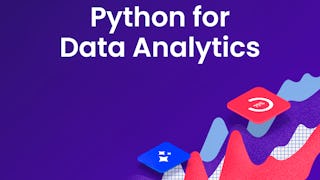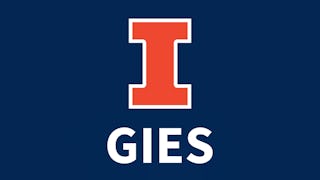This course focuses on developing Python skills for assembling business data. It will cover some of the same material from Introduction to Accounting Data Analytics and Visualization, but in a more general purpose programming environment (Jupyter Notebook for Python), rather than in Excel and the Visual Basic Editor. These concepts are taught within the context of one or more accounting data domains (e.g., financial statement data from EDGAR, stock data, loan data, point-of-sale data).



Accounting Data Analytics with Python
This course is part of Accounting Data Analytics Specialization


Instructors: Ronald Guymon
13,971 already enrolled
Included with 
(105 reviews)
What you'll learn
Know how to operate software that will help you create and run Python code.
Execute Python code for wrangling data from different structures into a Pandas dataframe structure.
Run and interpret fundamental data analytic tasks in Python including descriptive statistics, data visualizations, and regression.
Use relational databases and know how to manipulate such databases directly through the command line, and indirectly through a Python script.
Skills you'll gain
Details to know

Add to your LinkedIn profile
8 assignments
See how employees at top companies are mastering in-demand skills

Build your subject-matter expertise
- Learn new concepts from industry experts
- Gain a foundational understanding of a subject or tool
- Develop job-relevant skills with hands-on projects
- Earn a shareable career certificate


Earn a career certificate
Add this credential to your LinkedIn profile, resume, or CV
Share it on social media and in your performance review

There are 9 modules in this course
In this module, you will become familiar with the course, your instructor and your classmates, and our learning environment. This orientation module will also help you obtain the technical skills required to navigate and be successful in this course.
What's included
3 videos5 readings1 discussion prompt1 plugin
This module serves as the introduction to the course content and the course Jupyter server, where you will run your analytics scripts. First, you will read about specific examples of how analytics is being employed by Accounting firms. Next, you will learn about the capabilities of the course Jupyter server, and how to create, edit, and run notebooks on the course server. After this, you will learn how to write Markdown formatted documents, which is an easy way to quickly write formatted text, including descriptive text inside a course notebook.
What's included
15 videos3 readings1 assignment1 programming assignment1 discussion prompt3 ungraded labs
This module focuses on the basic features in the Python programming language that underlie most data analytics programs (or scripts). First, you will read about why accounting students should learn to write computer programs. In the first lesson, you will also learn the basic concepts of the Python programming language, including how to create variables, basic data types, and mathematical operators, and how to document your programs with comments. Next, you will learn about Boolean and logical operators in Python and how they can be used to control the flow of a Python program by using conditional statements. Finally, you will learn about functions and how they can simplify developing and maintaining programs. You will also learn how to create and call functions in Python.
What's included
13 videos2 readings1 assignment1 programming assignment4 ungraded labs
In this module you will learn about working with fundamental data structures in Python: strings, tuples, lists, and dictionaries. You will also learn about how to write loops for performing repetitive tasks.
What's included
16 videos2 readings1 assignment1 programming assignment4 ungraded labs
In this module you will learn about creating and using modules, which is a group of functions. You will then learn about two of the most important modules for data analytics: NumPy and Pandas. NumPy performs numerical calculations on large data arrays. Pandas simplifies procedures for working with panel data, also known as dataframes.
What's included
13 videos2 readings1 assignment1 programming assignment4 ungraded labs
This module focuses on using the Pandas dataframe to do some fundamental dataframe tasks including saving and reading dataframes, pivot table functions, filtering functions, and calculating descriptive statistics.
What's included
15 videos2 readings1 assignment1 programming assignment4 ungraded labs
In this module you will learn some basic elements of creating data visualizations in Python. You will then learn how to use the Matplotlib and Seaborn modules to help create some of the most commonly used one- and two-dimensional data visualizations.
What's included
17 videos2 readings1 assignment1 programming assignment4 ungraded labs
In this module you'll learn about the CRISP decision making framework to approach real-world problems. You'll also learn how to use linear regression to find and quantify relationships.
What's included
17 videos2 readings1 assignment1 programming assignment4 ungraded labs
This module focuses on relational database management systems (RDBMS) and how to interact with those using Python.
What's included
16 videos4 readings1 assignment1 programming assignment4 ungraded labs1 plugin
Instructors


Offered by
Recommended if you're interested in Business Essentials


Simplilearn


DeepLearning.AI


University of Illinois Urbana-Champaign
Build toward a degree
Why people choose Coursera for their career




Learner reviews
105 reviews
- 5 stars
63.80%
- 4 stars
22.85%
- 3 stars
4.76%
- 2 stars
5.71%
- 1 star
2.85%
Showing 3 of 105
Reviewed on Apr 15, 2023
A great course for someone who is just starting with Python. The materials are well designed.
Reviewed on Mar 27, 2022
very useful and important to computer science engineering students
Reviewed on Nov 30, 2020
It is very easy to learn and also very interesting because you can modify and try other things.
New to Business Essentials? Start here.

Open new doors with Coursera Plus
Unlimited access to 10,000+ world-class courses, hands-on projects, and job-ready certificate programs - all included in your subscription
Advance your career with an online degree
Earn a degree from world-class universities - 100% online
Join over 3,400 global companies that choose Coursera for Business
Upskill your employees to excel in the digital economy
Frequently asked questions
Once you enroll for a Certificate, you’ll have access to all videos, quizzes, and programming assignments (if applicable). If you choose to explore the course without purchasing, you may not be able to access certain assignments.
You will be eligible for a full refund until 2 weeks after your payment date. You cannot receive a refund once you’ve earned a Course Certificate, even if you complete the course within the 2-week refund period. View our full refund policy.
Yes! Coursera provides financial aid to learners who would like to complete a course but cannot afford the course fee. To apply for aid, select "Learn more and apply" in the Financial Aid section below the "Enroll" button. You'll be prompted to complete a simple application; no other paperwork is required.
More questions
Financial aid available,




